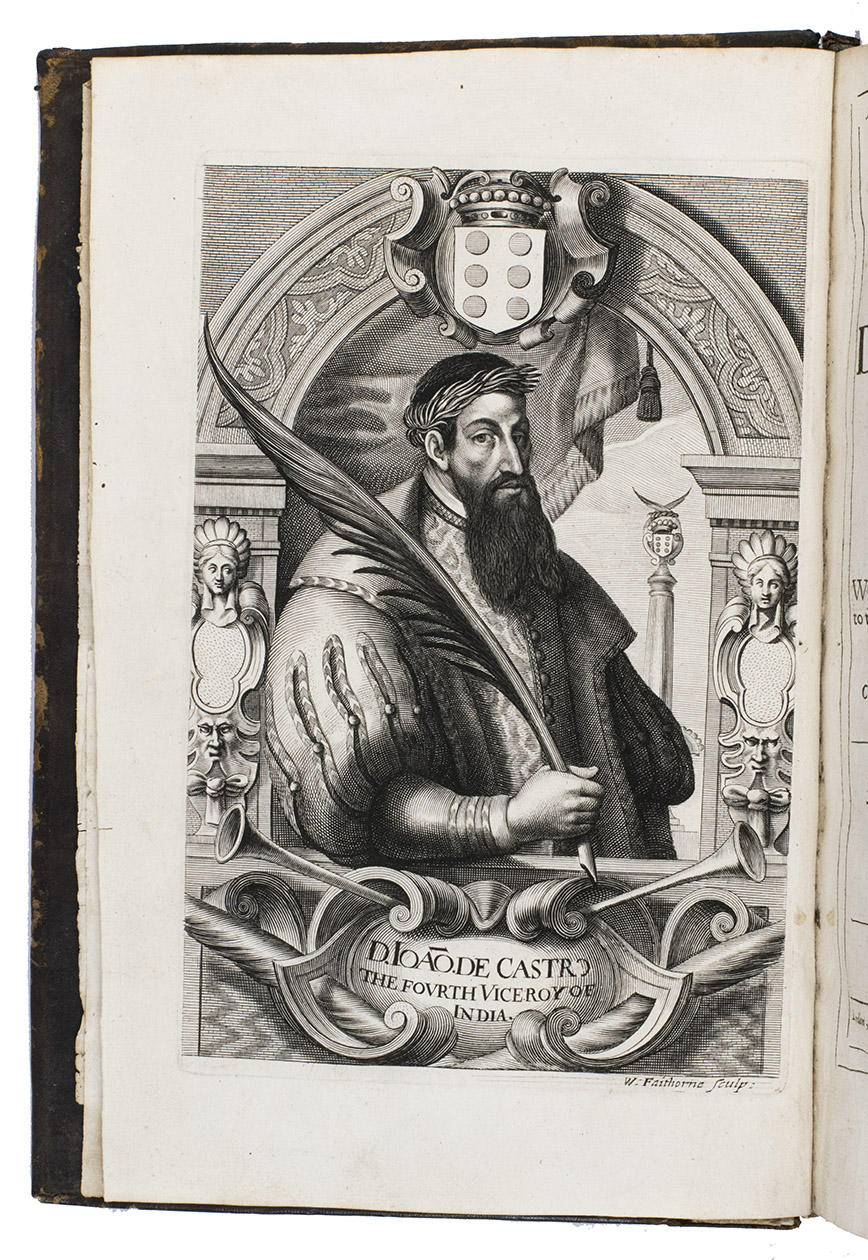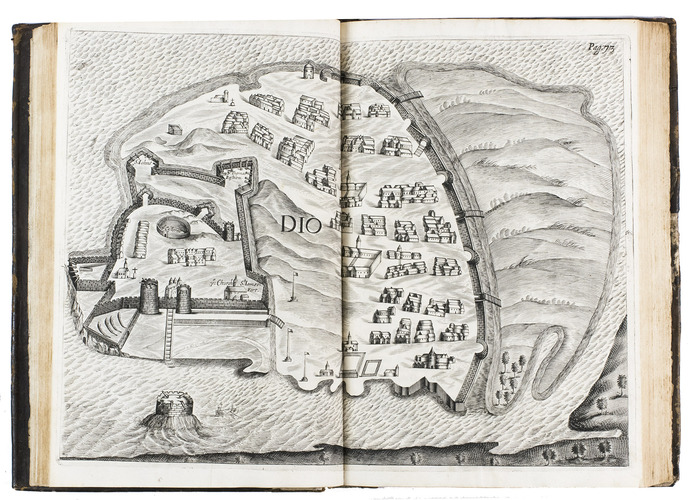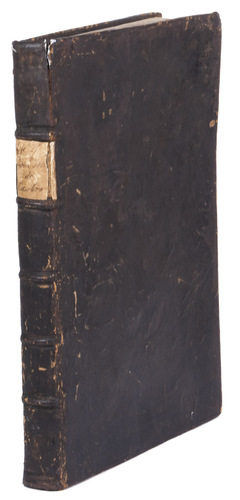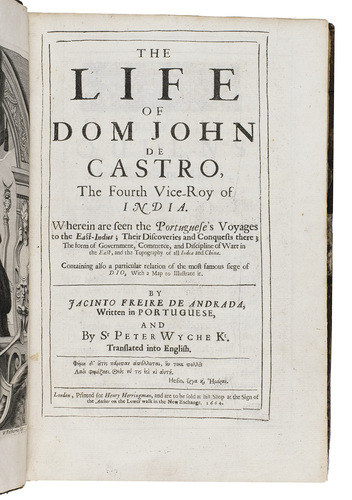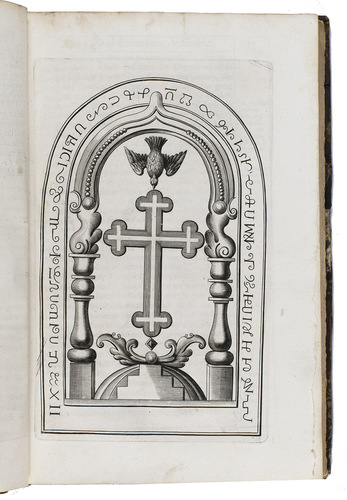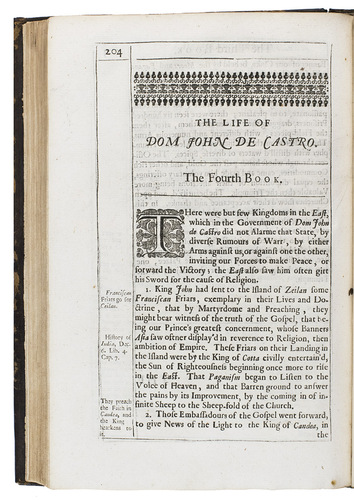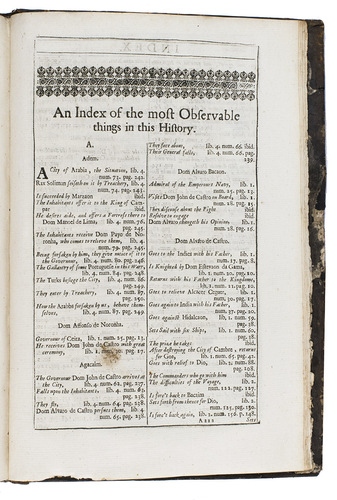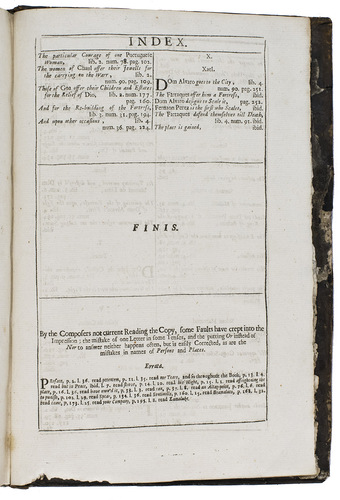FREIRE DE ANDRADE, Jacinto and Peter WYCHE (translator).
The life of Dom John de Castro, the fourth Vice-Roy of India. Wherein are seen the Portuguese's voyages to the East-Indies; their discoveries and conquests there; the form of government, commerce, and discipline of warr[!] in the East, and the topography of all India and China. Containing also a particular relation of the most famous siege of Dio, with a map to illustrate it.
London, Henry Herringman, 1664. Folio. With a full-page engraved portrait of D. João de Castro, the fourth viceroy of India as a frontispiece, signed "W. Faithorne sculp.", one full-page engraved illustration of the shrine of St. Thomas in Meliapor - including its inscriptions in Sanskrit - which already existed at the time of the Portuguese arrival in India, and one double page engraved map (view) of Diu and its fortress. Contemporary blind-tooled calf. [1], [1 blank], [18], 272, [19], [1 blank] pp.
€ 16,500
First edition of the English translation of the notable biography of the fourth viceroy of Portuguese India, D. João de Castro (Lisbon, 1500 - Goa, 1548). De Castro was a renowned 16th-century Portuguese nobleman, scientist, naval officer, and writer. As a young man, he studied under the famous Portuguese mathematician and cosmographer Pedro Nunes together with Luis, Duke of Beja, the second son of King Manuel I of Portugal. They became lifelong friends and Castro also accompanied Dom Luis to the siege of Tunis in 1535.
De Castro sailed with, served under, and was connected to several prominent 16th-century Portuguese (noble-) men. His uncle, Garcia de Noronha, was the third viceroy of India, with whom he first sailed for India in the late 1530s. There, De Castro participated in the relief of Diu, which was besieged as part of the struggle for the possession of Diu and its fort due to its strategic importance as an outpost and dominance in that part of Portuguese India. He was responsible for the overthrow of Mahmud, King of Gujarat, whose interests threatened the Portuguese control of Goa coast. Furthermore, De Castro also served under Estêvão da Gama, second son of the famous Portuguese explorer Vasco da Gama, on expeditions to Suez and the Red Sea. Back in Portugal, in 1543, he was named commander of a fleet sent to clear Atlantic Europe of pirates, and two years later was sent with a fleet of six ships back to the East, where he was rewarded with the positions of governor and viceroy of Portuguese India. Unlike previous governors and viceroys of India, De Castro was actively interested in Indian culture and religion. De Castro was possibly also connected to Saint Francis Xavier, who served in the Jesuit mission in Portuguese India in the 1540s, as he was supposed to have died in Xavier's arms in 1548.
During his travels between Portugal and India, including the expeditions he undertook with Da Gama along the Arabian coasts and to Egypt, De Castro collected important navigational, geographical and hydrographical information about these areas, which he presented in three "rutters" or itineraries/logbooks (in Portuguese: roteiros): Roteiro de Lisboa a Goa about his first voyage to India in 1538, Roteiro de Goa a Diu (written around 1539, regarding De Castro's rescue fleet relieving the Gujurati-Ottoman siege of the Portuguese fortress of Diu, and Roteiro do Mar Roxo (the Red Sea between East Africa and the Arabian Peninsula was then known as the "purple sea" - Mar Roxo). In his first rutter, De Castro recorded values of magnetic declination in the Atlantic and Indian Oceans, which he obtained through experiments with a magnetic needle on board. This early observation of the phenomenon of magnetic declination in the sixteenth century was useful for the study of terrestrial magnetism in later centuries.
The hinges are somewhat weakened, the boards are slightly rubbed, both pastedowns have come loose from the inside of the boards, revealing an inscription on the inside of the front board in brown ink "H. 1. 13 [crossed out]" and "C 7. 18", and an inscription in brown ink on the recto of the front paste-down "E F G H". Some occasional, very minor foxing, the foot edge of the 15 leaves is very slightly damages, not affecting the text in any way. Overall in good condition. ESTC R7129 (17 copies in the UK & US); Wing F 2155; WorldCat 835169356 (1 copy), 1064239444 (1 copy), 643713038 (1 copy), 1378914397 (1 copy); cf. Innocencio III, p. 239 (Portuguese ed.).
Related Subjects:
